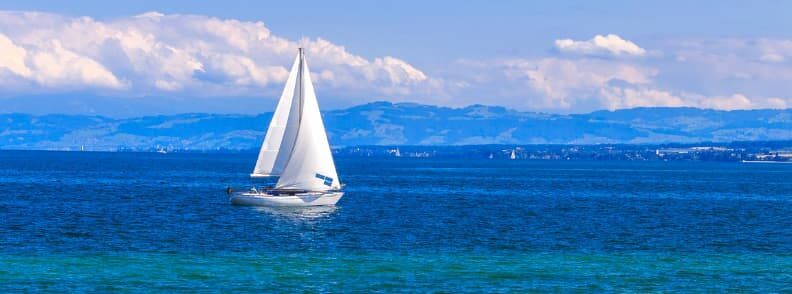The best day trips from Athens give you access to the country’s most remarkable places without the need to repack or relocate. From world-famous ruins to island villages and forested peaks, Athens day trips unlock an incredible mix of landscapes and cultures, all within reach of the capital by ferry, train, bus, or car.
Athens works perfectly as a travel base. The city’s transport network makes it easy to plan Athens day tours for any interest: history lovers chasing myths, nature fans looking for a swim or hike, solo travelers and families on a time budget, or budget-conscious visitors hoping to explore more for less.
Best Day Trips from Athens Greece
In this Athens travel guide, you’ll find the top 10 Athens day trips that I’ve personally tested and recommend, plus 8 bonus ideas for return travelers or anyone craving quieter corners. Each includes clear advice on how to get there, what to do, and whether to go self-guided or book a tour, so you can spend more time enjoying Greece and less time stressing about logistics.
If you’re planning your first time in Greece, or just looking to make your city stay more memorable, this is the only resource you need! You can visit beaches, mountain monasteries, and ancient ruins all within 1-3 hours from Athens.
Quick Comparison Table: Distance, Duration, DIY or Tour, Cost
If you’re short on time or just want the facts, this Athens day trips comparison table gives you a fast way to decide what fits your vacation best. These are actual travel times, not what brochures promise. Each cost range reflects average spend per person for DIY or basic guided options.
| Destination | Type | Distance from Athens | Travel Time Roundtrip | DIY Feasible | Guided Tour Available | Budget Range (€) | Best for | Highlight |
|---|---|---|---|---|---|---|---|---|
| Delphi | Ancient ruins | 180 km | 5.5-6 hrs | ✅ Yes (Bus/Car) | ✅ Yes | 30-100 | History lovers | Temple of Apollo |
| Meteora | Scenic + UNESCO | 360 km | 9-10 hrs | ⚠️ Only by train | ✅ Yes | 40-120 | Nature, photo lovers | Cliff-top monasteries |
| Cape Sounion | Half-day coastal | 70 km | 3.5-4 hrs | ✅ Yes (Bus/Car) | ✅ Yes | 15-60 | Sunset seekers | Temple of Poseidon |
| Aegina | Island | 40 km (by sea) | 2-3.5 hrs | ✅ Yes (Ferry) | ✅ Yes (Cruise or Local) | 20-75 | Foodies, couples | Pistachios + Temple of Aphaia |
| Hydra | Island | 70 km (by sea) | 4-6 hrs | ✅ Yes (Ferry) | ✅ Yes (Cruise) | 30-90 | Car-free charm | Stone mansions + donkeys |
| Poros | Island | 60 km (by sea) | 3.5-4.5 hrs | ✅ Yes (Ferry) | ✅ Yes (Cruise) | 25-85 | Off-season escape | Clock tower views |
| Mycenae & Epidaurus | Archaeological combo | 130-140 km | 6-7 hrs | ⚠️ With car only | ✅ Yes (Combo Tours) | 40-100 | History buffs | Tomb of Agamemnon |
| Nafplio | Seaside town | 140 km | 5-6 hrs | ✅ Yes (Bus/Car) | ✅ Yes | 25-90 | Architecture fans | Palamidi Fortress |
| Ancient Corinth | Quick access | 85 km | 2.5-3.5 hrs | ✅ Yes (Train/Car) | ✅ Yes | 10-55 | Short trips | Acrocorinth hike |
| Lake Vouliagmeni | Relaxing spa | 25 km | 1.5-2 hrs | ✅ Yes (Bus/Car) | ⚠️ Limited | 10-30 | Nature + wellness | Thermal lake swiim |
Notes:
- ⚠️ means DIY is possible but not ideal for first-timers or without local knowledge
- Ferry costs vary by speedboat vs standard (e.g., Poros via fast ferry saves time but costs more)
- Tour prices are for basic group tours. Private or VIP options are much higher
- All times are round-trip from Athens and include a reasonable time at the destination.
Insider Travel Tip: If you’re considering Delphi, allow time for the museum and a lunch stop in Arachova. It’s worth the detour if you’re driving.
How to Choose the Right Day Trip from Athens
Choosing the best day trips from Athens depends on more than just distance. What makes a destination right for you is how much time you have, what kind of traveler you are, and whether you want a relaxed wander, a beach break, or a deep dive into ancient history.
Before locking in your plans, match your travel style and available time to one of the options below. This saves you from wasting a day on something that doesn’t fit your mood, or worse, rushing through a site that really needed a full afternoon.
Best Athens Day Trip Based on Your Travel Style
- History lover? Choose a full-day trip to Delphi, Mycenae, or Ancient Corinth. These are top choices for ancient sites with real storytelling power. Visit temples, tombs, theaters, and museums.
- Nature-focused? Go for Meteora or Mount Parnitha. Both offer walking trails, high viewpoints, and fresh air escapes from the city.
- Foodie or island explorer? Aegina has temple ruins, pistachio treats, and fresh seafood, while Poros delivers slow island charm and beachside taverna lunches.
- Romantic getaway? Hydra or Nafplio are your go-to options. Uncover coastal views, neoclassical architecture, and no city noise.
- Short on time? Cape Sounion is ideal. You’ll be back in Athens before dinner with sunset photos in your pocket.
- Family travel? Stick to easier routes like Lake Vouliagmeni for a safe swim, Aegina for a short ferry, or Corinth Canal + Ancient Corinth for short travel and variety.
Best Athens Day Trip Based on Time Available
- Half-day trips from Athens
- Cape Sounion (sunset at the Temple of Poseidon)
- Corinth Canal + Ancient Corinth
- Lake Vouliagmeni.
- Full-day trips from Athens
- Delphi
- Meteora
- Nafplio
- Aegina
- Poros
- Hydra
- Mycenae & Epidaurus.
- Overnight-worthy trips
- Meteora (especially if traveling by car or train)
- Poros or Aegina in the low season (for peaceful island nights)
- Nafplio, if you want to combine beaches, museums, and a slow pace.
Disclosure: Some of the links below are affiliate links. This means that at no extra cost to you, The Travel Bunny will earn a small commission if you click through and make a purchase. Thank you!
1. Delphi, the Oracle’s Mountain Sanctuary
Among the best day trips from Athens, Delphi stands out for its dramatic setting, layered mythology, and sheer scale. Perched on the slopes of Mount Parnassus, the ancient sanctuary was once considered the center of the world. Today, it’s a UNESCO World Heritage site that still feels mysterious and monumental. If you’re drawn to ancient Greece, this is one of the Athens day trips you shouldn’t skip.
Why You Should Visit Delphi
Delphi was home to the most important oracle in the classical world. Pilgrims came from across Greece and beyond to seek guidance from the priestess of Apollo. The sanctuary’s role in shaping ancient politics and religion gives it enormous historical weight, but it’s the physical location that makes it unforgettable. The ruins spill down a steep hillside, with sweeping views over the olive-strewn valley of Phocis. You’ll find temples, treasuries, a theater, a stadium, and one of the best small museums in the country, all connected by a sloping sacred way. There’s enough here to impress history lovers, photographers, and travelers who just want to stand in a place that once held the ancient world’s attention.
How to Get to Delphi from Athens
Delphi is around 180 kilometers northwest of Athens and takes about two and a half to three hours each way. It’s possible to visit independently by intercity bus, rent a car, or join a full-day tour. The KTEL bus to Delphi departs from Liosion Bus Station and drops you at the modern village near the archaeological site. Buses typically leave in the morning and return late afternoon, and the trip costs around €15 one way. If you’re staying in central Athens, allow time to get to the terminal by taxi or metro.
Driving is straightforward and scenic. The route winds through mountain landscapes, with good roads and clear signs. You’ll have more flexibility to stop in nearby towns, especially Arachova, which makes a great lunch or coffee break. Parking is available near the museum, though it can fill up during peak season.
Guided Athens day tours to Delphi are a popular option and often include hotel pickup, a licensed guide, entrance fees, and a short stop in Arachova. If you want context and ease, this is the simplest way to visit, especially if you’re not planning to rent a car.
Best Things to See in Delphi
The archaeological site unfolds in layers. The Temple of Apollo is the central ruin, where the oracle once sat. Behind it, the ancient theater still offers commanding views of the mountains and the valley. Above that is the stadium, once host to the Pythian Games. Lower down, you’ll find the Athenian Treasury, one of the most intact monuments, and the Sacred Way, the ceremonial path that once greeted processions from all over the Greek world.
The Delphi Archaeological Museum, included with your site ticket, is small but exceptional. Don’t miss the Charioteer of Delphi, one of the best-preserved bronze sculptures from antiquity, and the Sphinx of Naxos, which stood on a tall column at the sanctuary entrance. The museum puts faces to the ruins outside and gives you a better understanding of the site’s panhellenic reach.
On your return or after your visit, make a short stop in Arachova, a nearby mountain village known for its wool goods, local cheeses, and stone houses. Even a short break here can help break up the journey and round out the day with something less ancient and more lived-in.
Athens Day Trip to Delphi Cost Breakdown
If you’re traveling by KTEL bus, budget around €30 for a round trip. The entrance fee to the site and museum is €12 in high season (April to October) and €6 in low season. Entry is free on certain dates, such as the first Sunday of the month between November and March.
Guided tours from Athens typically range from €60 to €100, depending on inclusions, with lunch and entry tickets sometimes bundled in. Car rental starts around €40–€50 per day, plus fuel. Delphi is a full-day commitment, but it’s one of the few Athens day trips that truly justifies the time and effort, offering depth, beauty, and a real sense of place.
Greece Budget Travel Tip: Bring snacks. Delphi restaurants are expensive for what they offer.

2. Meteora, the Monasteries in the Sky
Of all the Athens day trips you can take, none feel as surreal as Meteora. This collection of Byzantine monasteries perched atop sandstone pillars looks more like a fantasy movie set than a real Greek destination. It’s a UNESCO World Heritage site that draws pilgrims, hikers, photographers, and travelers who want to see something extraordinary. If you’re looking for a day trip that combines landscape, spirituality, and architecture, Meteora is unmatched.
What Makes Meteora Unique
Meteora is both a geological wonder and a cultural landmark. The name means suspended in the air, and that’s exactly how it feels. Massive rock formations rise from the Thessalian plain, and atop them sit centuries-old monasteries built by monks who climbed or used rope baskets to reach these isolated heights. At its peak, Meteora had 24 monasteries. Today, six are still active, each clinging to cliffs hundreds of meters above the valley floor.
The site’s power lies in the contrast: monumental natural forces shaped the rock, but it was human determination that carved stairs, hauled stones, and created sanctuaries in the sky. This rare combination of geology and spirituality makes Meteora one of the most atmospheric day trips from Athens and a place that feels far removed from city life.
Did You Know? Queen Mary of Romania (you may remember her from the article about Balchik Bulgaria) was the first woman allowed inside the Great Meteor Monastery. This is also the most important monastery complex you’ll visit on your Meteora day trip from Athens.
Best Way to Reach Meteora from Athens
Meteora is about 350 kilometers from Athens, and the journey takes around four to five hours each way. You can get there by train, car, or with a guided tour. While it’s a long trip for one day, many travelers make it work, and it’s worth it if you time it right.
The train is the most comfortable way to visit independently. Trains leave Athens Larissa Station and arrive at Kalambaka, the small town just below Meteora. A direct Intercity train takes around 4 hours and offers scenic views of the countryside. It’s more relaxing than driving, and gives you a chance to rest on the return. From Kalambaka, taxis and local buses can take you up to the monasteries, or you can hike up if you’re fit and the weather is good.
If you choose to drive, expect a five-hour route through central Greece. The roads are in good condition, and it’s possible to leave early and return late for a packed day. Driving gives you full flexibility to stop along the way and to explore the monasteries at your own pace. However, parking near the monasteries is limited, and fatigue can be an issue on the return.
There are also guided Meteora day tours from Athens, many of which include hotel pickup, train tickets, a local guide, and transfers to the monasteries. Some even include lunch and audio guides. These tours typically leave early and return late, and they’re ideal if you want to see as much as possible in a single day without managing the details yourself.
Which Monasteries to Visit in Meteora Kalambaka
Six monasteries are open to visitors on a rotating schedule. You won’t have time to see them all in one day, but visiting two or three offers a balanced experience. The Great Meteoron Monastery is the largest and most visited, known for its panoramic views and small museum. Varlaam Monastery is close by and equally photogenic, with a beautiful chapel and preserved frescoes. St. Stephen’s Monastery, easier to access with a bridge instead of stairs, is a good choice if you’re short on time or traveling with limited mobility.
Other options include Roussanou Monastery, which is run by nuns and offers sweeping views, and Holy Trinity, which involves more climbing but rewards with solitude and dramatic scenery. Most monasteries require modest dress (covered shoulders and long skirts or trousers) and charge a small entrance fee (around €3 per person).
Plan your visit according to opening hours, as each monastery has at least one day per week when it’s closed. These schedules vary, so check in advance to avoid surprises.
DIY or Guided Tour to Visit Meteora?
It depends on what kind of traveler you are. If you’re confident managing logistics, taking the train to Kalambaka and arranging your own transfers gives you flexibility and keeps costs lower. This also works well for slow travelers spending the night in town.
For those who want to see the highlights efficiently, a guided Meteora day tour is the best option. It removes the complexity of train schedules, monastery closures, and uphill walks. You’ll also gain context from a knowledgeable guide, something you won’t get on your own unless you’ve read ahead.
Personal Note: We drove, but I’d take the train next time. Better for the views and less tiring.
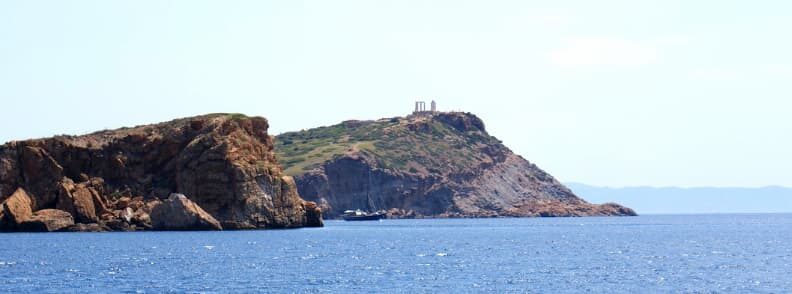
3. Cape Sounion and Sunset at the Temple of Poseidon
When it comes to half-day trips from Athens, few destinations rival the drama and simplicity of Cape Sounion. Set at the southernmost tip of the Attica peninsula, this rocky promontory is crowned by the Temple of Poseidon, one of the most iconic classical monuments in Greece. The setting is pure theatre: ancient columns standing guard over the Aegean Sea, with views that stretch all the way to the Cyclades on a clear day. If you’re short on time but want a memorable escape, this is one of the most rewarding Athens day trips you can take.
Is Cape Sounion the Best Half-Day Trip from Athens?
Cape Sounion is often recommended for travelers who want to leave the city without committing to a full-day excursion. Its appeal lies in the balance: it’s close, scenic, culturally rich, and offers a clear focal point: the Temple of Poseidon. Unlike other day trips that require careful planning or hours on the road, Sounion is straightforward. You can leave Athens in the afternoon, catch the sunset, and be back in the city by evening.
The site itself is compact but breathtaking. You don’t need more than an hour to explore the ruins and walk the surrounding paths, but the impact is long-lasting. The temple’s columns, built from gleaming white marble, stand against the blue of the Aegean Sea and sky, making it one of the most photogenic places in mainland Greece. For solo travelers, couples, or anyone on a tight itinerary, it’s a natural choice.
How to Visit Cape Sounion from Athens: Bus vs Car vs Sunset Tour
Cape Sounion is about 70 kilometers southeast of Athens. The drive along the coast takes around 90 minutes, following the scenic Athens Riviera. You can visit by car, public bus, or on a sunset tour.
Driving gives you the most flexibility. The coastal route is easy to follow and filled with sea views and small coves. Parking is available at the site, and you can set your own pace. If you’re traveling with others or planning to pair the trip with a beach stop, car rental is a smart option.
The KTEL bus from Athens departs from Pedion Areos and stops directly at the archaeological site. It’s the cheapest option, though less frequent than other routes, and you’ll need to plan your return carefully. This works best during the day rather than after sunset.
Guided sunset tours at Cape Sounion are a popular choice and include transport, a licensed guide, and sometimes a short Athens Riviera stop. These tours are timed for golden hour and often give you insights into the mythology and architecture that you might otherwise miss. If you’re interested in Athens day tours that are easy and efficient, this is one of the best.
Sunset Timing + Best Photo Spots at Cape Sounion
Sunset is the main draw here. The Temple of Poseidon faces west, and as the sun dips into the sea, the marble columns catch the light in shifting tones of gold and amber. It’s one of the few places near Athens where you can watch the sun set over the water with a classical monument in the foreground.
Arrive at least 30 to 45 minutes before sunset to allow time for walking, framing your shots, and finding a quiet perch. The best angles are slightly downhill from the temple platform, where you can capture the structure silhouetted against the sky. Photography is unrestricted, but tripods may be restricted during busy hours or events.
If you want fewer people in your frame, avoid weekends and go outside of peak summer. Weekdays in spring or autumn offer better light and fewer crowds.
Combine Cape Sounion with Lake Vouliagmeni?
If you have a full afternoon, it’s worth pairing Cape Sounion and Lake Vouliagmeni, a warm freshwater lake set in a limestone crater closer to Athens. The lake’s mineral-rich waters stay warm year-round and are known for their therapeutic properties. It’s a great stop for a swim or light lunch on the way to Cape Sounion.
To do both in one trip, rent a car or book a custom tour. Public transport doesn’t make it easy to connect the two directly. The lake is about 25 minutes from Sounion by road, and there’s a seaside drive connecting the two with plenty of Riviera views along the way.
An alternative to make this day trip from Athens a bit longer and more intense is to arrive at Sounion Cape for the sunset after visiting Vravron and Thorikos. At Vravros, you can visit an open-air archaeological site, while in Thorikos, you can explore the Mycenaean ruins of the settlement established in the 5th century BC.
Greece Insider Tip: Visit in shoulder season (April or October) for fewer crowds and golden light.
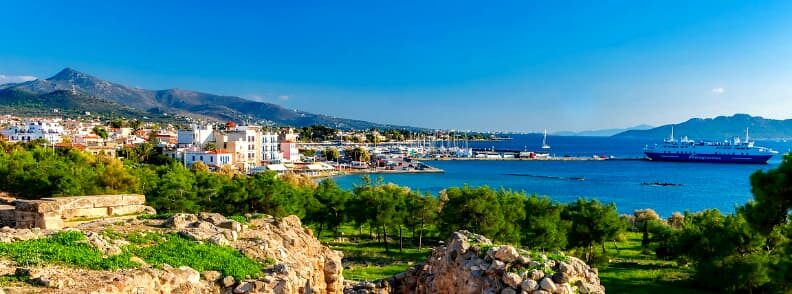
4. Aegina, a Close Island With a Tasty Twist
If you’re looking for island day trips from Athens that don’t require hours of travel or overnight stays, Aegina is the easiest and most rewarding choice. Just an hour from Piraeus, the island offers classical ruins, relaxed beach towns, and one of the best-known local food products in Greece: pistachios. It’s ideal for a quick change of scene without the logistics of longer journeys, making it one of the smartest Athens day trips, especially for first-timers.
Why Aegina Is the Perfect First Island from Athens
Aegina combines accessibility with variety. It’s close enough to be spontaneous but big enough to spend the entire day without running out of things to see. You can swim, explore a major ancient temple, walk along a harbor lined with fishing boats, and eat well, all without needing a car. That’s what makes Aegina ideal as a first taste of the Greek islands. It’s calm, compact, and culturally rich, with far fewer crowds than places like Santorini or Mykonos.
Because of its location in the Saronic Gulf, Aegina was historically a naval rival to Athens. Today, its pace is slower, its towns quieter, and its appeal rooted in a mix of archaeology, nature, and food culture. It’s also the island that many Athenians escape to on weekends, which says a lot.
Getting to Aegina from Athens
Aegina is served by frequent ferries from Piraeus, Athens’ main port. Standard car ferries take around 70 minutes, while high-speed boats can get you there in 40 minutes. The fast boats don’t take vehicles, but they’re ideal for day trips with just a backpack or beach bag.
Tickets can be purchased online or directly at the port, though availability is tight during summer weekends and holidays. Most services arrive at Aegina Town, the island’s main port and capital. If you plan to visit Agia Marina or the Temple of Aphaia, you can catch a local bus or taxi from the port. The high-speed boats save time but can be a bit rough on windy days, so check conditions if you’re sensitive to motion.
The early morning departures and early evening returns make Aegina one of the most practical Athens day tours you can do independently. You don’t need to book a tour unless you prefer a structured itinerary.
What to Do on Aegina Island
The star attraction is the Temple of Aphaia, perched on a hill above the pine forests of the island’s eastern side. It forms part of a theoretical “sacred triangle” with the Parthenon and the Temple of Poseidon at Cape Sounion. Unlike those other two sites, it’s often quiet and surrounded by nature rather than city. The Doric temple is well preserved, and the views from the top are some of the best on the island.
Nearby, the village of Agia Marina offers a beach, cafes, and clear water swimming. It’s less polished than island resorts but perfectly pleasant for a midday break. If you have extra time, you can also explore Paleochora, the island’s former capital filled with ruins of old churches, or the Monastery of Agios Nektarios, one of the most visited pilgrimage sites in Greece.
Back in Aegina Town, walk the harborfront or browse the pistachio stalls set up just outside the port. The island is famous for its Aegina pistachios, which have a protected designation and are sold in all kinds of forms, from roasted and salted to pesto and nut butter.
Aegina Travel Tip: Try the pistachio “Nutella” or a scoop of local ice cream. The ice cream is quite satiating, so one scoop is more than enough.
One-day Cruise in the Saronic Gulf from Athens
Instead of visiting one island near Athens, why not see three? You can book a one-day cruise in the Saronic Gulf and travel to Aegina and two other islands: Agistri and Moni.
A small island only 10 minutes away by boat from Aegina, Agistri only has three settlements: Megalochori, Skala, and Limenaria. With a total population of around 1,500 inhabitants, it’s a great place to relax away from the crowded city of Athens. The best place to visit on Agistri is the long, golden beach between Megalochori and Skala.
On Moni Island, you can go swimming and even do some snorkeling. While the waters are of an enchanting blue, the beaches are mostly rocky, which may seem like a minus for some. For those, I’ll mention that there is also a small sandy beach available!
And for hikers and World War II enthusiasts, I recommend going up to the highest point of Moni. It’s an easy hike, and besides a great view at the end, you’ll also find two stone sheds built and used by the Germans during the Second World War.
Alternative: You can also book a one-day cruise in the Saronic Gulf from Athens to sail to Aegina, Hydra, and Poros. But, in my opinion, this would feel too rushed. Read below about Hydra and Poros, and you’ll find out why.
5. Poros, My Favorite Escape From Athens
If you’re searching for island day trips from Athens that are peaceful, scenic, and free from big crowds, Poros is the one I always return to. It’s close enough for a day but far enough to feel like a true break. The pine-covered hills, neoclassical houses, and gentle rhythm of local life give Poros a character that’s hard to describe but easy to enjoy. While most visitors rush to Hydra or Aegina, Poros stays quieter, especially off-season, which is exactly why it’s my favorite.
What Makes Poros Special (Even Off-Season)
Poros is technically two islands (Sphairia and Kalavria), connected by a narrow isthmus. The main town is built amphitheatrically along the waterfront, with tiled roofs, narrow lanes, and a hilltop clock tower that’s visible from the moment you arrive. It’s a proper Greek island in miniature: elegant but unpretentious, green but not wild, developed but never overbuilt.
In spring and autumn, Poros is still warm, the water is swimmable, and you’ll find space to breathe. You can sit at a seafront café with locals reading newspapers or climb the hillside without seeing another tourist. For those who like a softer kind of escape with no lines and no stress, this is one of the best Athens day trips you can take by ferry.
Ferry Tips to Get to Poros From Piraeus
Getting to Poros from Piraeus is straightforward. High-speed catamarans operated by companies like Saronic Ferries or Blue Star leave regularly and take around one hour. These boats dock right in Poros Town, so there’s no need to transfer or walk long distances.
If you prefer a slower, more scenic journey, conventional ferries take about two and a half hours but offer deck space and views of the coast. These can be a good option if you don’t mind the extra time. Tickets are easy to book online or at the port, but I recommend reserving ahead in high season.
The return is just as easy, making Poros one of the few islands where a same-day round trip still feels worth it. It’s also a good choice for people who want a less touristy version of a typical Athens day tour.
Top Things to Do on Poros Island
Once you step off the ferry, head uphill to the clock tower, the island’s best-known viewpoint. From the top, you’ll see the town’s red rooftops, the narrow channel that separates Poros from the Peloponnese, and the distant mountains beyond.
The town itself is great for walking. The lanes wind between houses, small churches, and flowering courtyards. If you want a swim, then walk or take a taxi to Love Bay or Askeli Beach. Both offer clean water and shade, even in summer. You won’t find loud beach bars or heavy development, which is part of Poros’ charm.
You can also rent a bike, stroll along the promenade, or just sit by the water and enjoy grilled fish at a quiet taverna. It’s not about ticking off sights here. It’s about slowing down and appreciating the details: a painted door, a sea breeze, a quiet morning…
Personal Note: This is my favorite island near Athens. It’s quiet, beautiful, and still warm off-season.
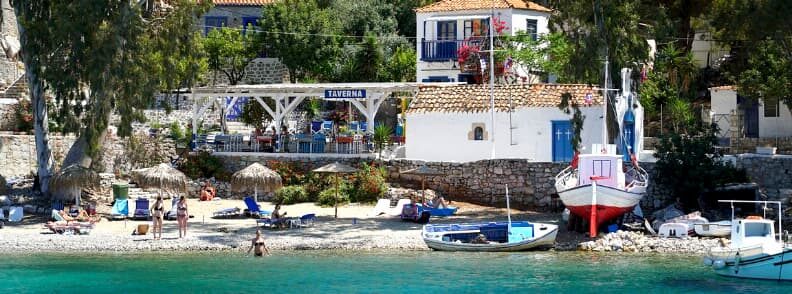
6. Hydra. Elegant, Car-Free, and Photogenic
Hydra is the most stylish of the Athens island day trips. Known for its preserved architecture, wealthy past, and absence of cars, it offers something few other destinations this close to the city can match: stillness. You won’t hear engines or see taxis. Just the sound of waves, footsteps on stone, and the occasional bray of a donkey. Artists, writers, and weekenders have long loved Hydra for this balance of calm and refinement. If you want a peaceful place to wander, take photos, and unwind without a checklist, Hydra delivers.
How to Get to Hydra From Athens
Hydra sits about 70 kilometers from Athens and is accessible only by sea. The high-speed ferry from Piraeus takes roughly 90 minutes and runs several times a day, though morning slots sell out quickly in high season. All boats dock in Hydra Port, the horseshoe-shaped harbor that forms the heart of island life. From there, everything is walkable.
There are no cars or motorbikes allowed on Hydra Island. Local transport is done on foot, by water taxi, or by donkey. If you’re not comfortable walking, this isn’t the island for you. But if you enjoy moving at a human pace, it’s ideal. To make a day trip work smoothly, aim for an early ferry from Athens and return before dark because there are no night boats.
What to See on Hydra Island
Hydra’s architecture is its main attraction. The waterfront is lined with neoclassical mansions once owned by naval families and sea captains. Many now serve as museums or private homes. The Hydra Museum Historical Archives gives context to the island’s maritime past and its role in Greece’s War of Independence. Just walking through the narrow streets behind the harbor feels cinematic: bright white walls, blue shutters, stone alleys, and terracotta roofs.
Donkeys replace cars as the island’s main form of heavy transport. You’ll see them hauling goods, guided by handlers through narrow paths where wheeled vehicles can’t go. Shops and galleries are tucked into courtyards and laneways, and several boutiques showcase local art and textiles. Hydra has a refined, lived-in charm, without the hard sell of more touristy islands.
You can also take a short walk along the coast to Kamini, a small fishing village with good tavernas and calm swimming spots. The walk is paved, quiet, and offers stunning sea views. If you stay for a late lunch or early dinner, you’ll see the light shift across the stone houses as the island winds down.
Why Hydra Is Great for Slow Travel
Hydra isn’t for rushing. The island rewards those who move slowly and notice details. There are no big sights to tick off, no tour buses, and no pressure to do anything. This makes it one of the most relaxing Athens day trips, especially if you’re already tired of crowds or traffic. Just being here is the point. You sit, you swim, you sip, you stroll. Everything happens on foot and at a measured pace.
For travelers who like simplicity and space to breathe, Hydra is the island you’ll remember long after you’ve left. It also stays lovely into the off-season, when most of the big cruise crowds have disappeared and the harbor returns to its quiet rhythm.
Hydra Travel Tip: Avoid weekends in summer. Ferries get packed with Athenians.
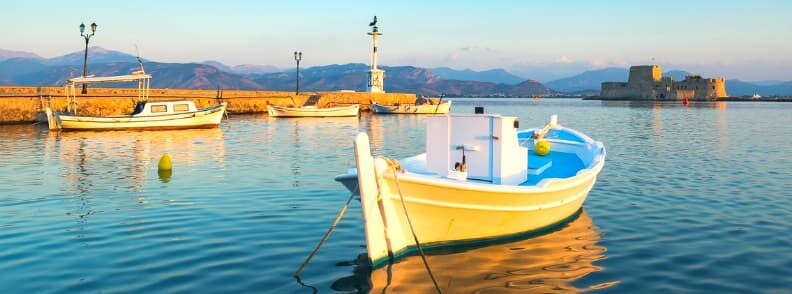
7. Nafplio, Greece’s Most Romantic Town
Nafplio is one of the most elegant and romantic day trips from Athens. With its pastel neoclassical facades, stone alleys, and Venetian architecture, it feels more Italian than Greek at first glance. Located on the eastern Peloponnese, this seafront town was modern Greece’s first capital and still carries a sense of faded grandeur. If you’re after a slower, more refined destination where you can stroll, sightsee, and dine all in one place, Nafplio is one of the best choices for a full-day getaway.
Things to Do in Nafplio
The centerpiece is the Palamidi fortress, perched on a hill above the town. You can drive up or climb the famously steep 999 steps for a wide-open view over the rooftops, harbor, and distant mountains. The site is well preserved and rarely crowded, with a series of bastions you can explore at your own pace.
Back in the Old Town, narrow lanes open onto shaded squares lined with cafés, small museums, and local shops. Nafplio blends Ottoman, Venetian, and Greek elements in a way that feels authentic rather than curated. Walk through Acronauplia, the oldest region of the town, and along the waterfront promenade toward the Bourtzi Castle, a small fortress built on a rocky islet just offshore. You can reach it by boat if it’s running, or simply enjoy the view from land.
Beyond sightseeing, Nafplio is made for wandering. The architecture, sea breeze, and soft light give it a romantic feel that’s hard to manufacture. It’s not flashy, but it’s deeply satisfying. It’s one of the few towns in Greece where you could easily spend hours doing very little and not feel like you missed anything.
How to Get to Nafplio From Athens
Nafplio is about 140 kilometers southwest of Athens and takes around two hours to reach by car or bus. If you’re driving, the route is fast and well-marked, passing over the Corinth Canal and into the rolling hills of the Argolis region. You’ll have full flexibility to stop along the way or pair your visit with nearby archaeological sites.
The KTEL bus to Nafplio departs from the Kifissos terminal and runs regularly throughout the day. The journey takes just over two hours, and the bus station in Nafplio is a short walk from the town center. Tickets cost around €15 one way. Buses are reliable and comfortable, making this an easy destination to visit independently without needing a tour.
For those who prefer ease or added context, some Athens day tours include Nafplio as part of a broader itinerary, often combined with Mycenae or Epidaurus. These are useful if you want a curated experience without dealing with transport.
Pair Nafplio With Mycenae?
If you’re already heading to Nafplio, adding Mycenae is both practical and worthwhile. The archaeological site is about 25 minutes away by car and can easily be visited before or after your time in town. Mycenae was once a powerful Bronze Age kingdom and is best known for its Lion Gate, Tomb of Agamemnon, and Cyclopean stone walls. The on-site museum is small but informative, and the ruins are spread across a sloping hillside with views over the Argolid plain.
Visiting both in one day gives you a blend of Greece’s mythic past and its modern elegance. If you start early, it’s completely doable without feeling rushed. This combination is one of the most balanced Athens day trips for travelers who like a mix of cultural depth and scenic downtime.
Visit Nafplio Tip: Most travelers visit Palamidi fortress during the heat of the day, but if you arrive early (just after it opens), you’ll have the whole site almost to yourself. The light is softer for photos, the climb is cooler, and you’ll beat the tour buses coming from Athens.
8. Mycenae & Epidaurus, Greece’s Ancient Heavyweights
For travelers interested in the deep layers of Greek history, pairing Mycenae and Epidaurus in a single day offers an unmatched archaeological experience. These two UNESCO World Heritage sites sit just 30 minutes apart in the northeastern Peloponnese and make for one of the most comprehensive and enriching Athens day trips. One reveals the world of Bronze Age kings and mythic warriors. The other, a masterpiece of Classical Greek theatre still praised for its near-perfect acoustics. Visiting both gives you a full picture of Greece’s ancient legacy from the age of Homer to the rise of Athens.
Why Visit Mycenae & Epidaurus in One Day
What makes this combination so powerful is how distinct yet connected the two sites are. Mycenae was the seat of a powerful kingdom during the Late Bronze Age and is deeply tied to Homeric legends of Agamemnon, the Trojan War, and the wealth of a lost civilization. Its architecture is massive and austere, built from huge stones and filled with symbolism and mystery. You can still walk through the Lion Gate, explore beehive tombs, and climb the palace complex that once ruled much of southern Greece.
Epidaurus, by contrast, is graceful. Its centerpiece is a 4th-century BCE theatre with acoustic engineering that still impresses modern architects. (Stand at the center of the stage and speak in a normal voice. Someone sitting in the top row can hear you clearly!) The theater is still used to this day for various performances, including ancient dramas, operas, modern dance performances, and symphonies.
The site of Epidaurus also includes the remains of a healing sanctuary dedicated to Asclepius, once a major pilgrimage site in the Greek world. This place was home to Asclepius, the son of Apollo, who had very strong healing powers. The Epidaurus Asclepion was a healing center used in the Greek and Roman world. Starting with the 6th century BC, people would come to the Asclepion to go to sleep on one of the many prepared beds. It was said that the god Apollo himself would whisper in their dreams what actions to take in order to heal themselves.
Together, these two places represent the shift from myth to medicine, from military power to artistic achievement. Few other day trips from Athens offer this kind of chronological and thematic range.
Tour or Drive to Mycenae & Epidaurus? (Route + Cost Comparison)
You can visit independently or on a guided tour. Driving from Athens takes about 90 minutes to Mycenae, followed by another 30 minutes to Epidaurus. From there, it’s a two-hour return. The roads are good, and signs are posted in both Greek and English. Renting a car from Athens gives you freedom to control your timing, take detours, or combine the trip with a stop in Nafplio, which lies between the two sites.
Expect fuel costs of around €25-€30 round trip, plus entry fees (€12 each for Mycenae and Epidaurus in high season). This option works well for confident drivers or travelers who want a flexible, self-paced itinerary.
Guided Athens day tours typically cover both sites and sometimes include Nafplio as a lunch stop. Prices range from €70 to €100 depending on inclusions. These tours are ideal if you want expert commentary and stress-free logistics. You won’t need to navigate or worry about opening hours, which can vary by season.
Highlights of This 2-in-1 Athens Day Trip
At Mycenae, the Lion Gate is one of the most famous entrances in the ancient world. It’s flanked by two carved lions and still stands as it did over 3,000 years ago. Beyond the gate, you’ll find Grave Circle A, where Schliemann claimed to find the mask of Agamemnon (now housed in the National Archaeological Museum in Athens). The Treasury of Atreus, a massive tholos tomb with a corbelled dome, is just outside the main complex and well worth the short walk.
At Epidaurus, the ancient theatre is the star. You don’t need a performance to appreciate it, just stand in the center and listen. The design channels sound flawlessly, and the atmosphere is surprisingly peaceful even when busy. Beyond the theatre, explore the sanctuary ruins, including the Tholos, an unusual circular structure whose original function is still debated.
Little-Known Mycenae Travel Tip: Most visitors enter Mycenae through the Lion Gate and walk uphill. But if you start with the Treasury of Atreus, about 400 meters before the main entrance, you’ll often have the site to yourself, and the scale of the Tholos tomb is even more impressive when you’re the only one inside.
9. Corinth Canal & Ancient Corinth, Easy Half-Day Trip from Athens
If you’re short on time but still want to experience an impressive slice of Greek history and engineering, Corinth Canal and Ancient Corinth make for one of the simplest half-day trips from Athens. This route doesn’t require a full day or a complex itinerary, and you’ll still get a strong mix of classical ruins, sea views, and a real sense of scale, especially if you happen to catch a boat passing through the narrow canal. It’s also one of the few Athens day trips that works well in the shoulder season or even winter, when other destinations may feel too far or weather-dependent.
What You Can Actually See On This Athens Half-Day Trip
The Corinth Canal itself is a narrow manmade channel that slices through the Isthmus of Corinth, linking the Aegean Sea to the Ionian Sea. Though only 6.4 kilometers long, the canal cuts through cliffs as high as 80 meters and creates a sheer passage that’s visually striking. Most visitors stop at the bridge crossing near Isthmia, where you can walk across and look down as tankers, tour boats, and even small yachts pass beneath. It’s especially dramatic from above if you catch a ship entering or exiting the waterway.
Just a short drive away, Ancient Corinth offers a well-preserved archaeological site with views of the surrounding plain and the looming hill of the Acrocorinth fortress above. The ruins include the Temple of Apollo, a Roman-era agora, a small museum, and early Christian landmarks connected to Saint Paul’s time in the city. If you’re interested in biblical history, this site has particular significance as one of the communities where Paul is known to have preached.
The Acrocorinth fortress, perched high above the ruins, is worth the detour if you have the time and stamina. It offers panoramic views and a vast network of walls, towers, and former cisterns. It’s a much less visited site, and you may have parts of it entirely to yourself.
Driving to Corinth from Athens vs Proastiakos Train
By car, it takes about an hour to reach Ancient Corinth from Athens. The roads are excellent, and the route is straightforward. If you’re already heading toward Nafplio or the Peloponnese, it’s an easy stop that doesn’t require a detour. You’ll find parking near the archaeological site and at the bridge over the canal.
If you prefer public transport, the Proastiakos suburban train runs from Athens Central (Larissa Station) to Corinth with a travel time of about 70 minutes. From the station, you’ll need a short taxi ride to the canal or Ancient Corinth, as neither is walkable from the train. This option works well if you don’t want to drive but still want to avoid a full tour.
There are also half-day Athens day tours that cover both the canal and the archaeological site, usually with a guide and return transfer. These are popular for cruise visitors or anyone with limited time.
Is the Corinth Worth a Detour or a Dedicated Trip?
That depends on your expectations. If you’re planning to explore the Peloponnese or combine this with a stop in Mycenae, Epidaurus, or Nafplio, then yes, it’s absolutely worth including. But if you only have time for one major site during your stay in Athens, Corinth is a solid but secondary choice after places like Delphi or Sounion.
That said, it’s a convenient option that doesn’t require much energy or planning, which makes it ideal if you’ve just arrived in Athens, have a few free hours, or want something manageable before a flight. It’s also one of the few archaeological sites near Athens that balances history with infrastructure: ruins, a museum, a fortress, and a canal, all in one trip.
Personal Corinth Travel Story: I passed through the Corinth Canal by sailboat, and it’s even more dramatic from the water. Looking up at the vertical walls on both sides while slowly navigating the narrow passage is something I’ll never forget. It gives you a real sense of how ambitious and audacious the canal project was (and still is, given its frequent collapses).
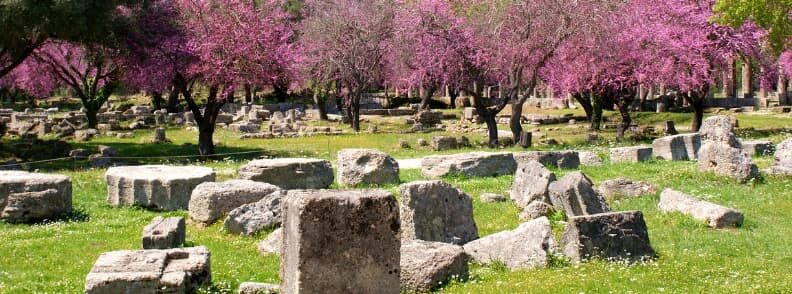
Day Trip to Ancient Olympia and the Corinth Canal
You can spend less time in the Corinth Canal area and head towards Ancient Olympia. This is where the ancient Olympic Games were born in Classical Greece. Besides the archaeological site, you can also visit the Archaeological Museum of Olympia and the Museum of the Olympic Games.
Don’t skip the Temple of Zeus, the Temple of Hera, the Pelopion, the Philipeion, and the Phidias workshop. And visit the stadium, of course!
10. Lake Vouliagmeni for a Thermal Swim + Spa Escape
For a half-day escape that doesn’t involve ruins, ferries, or long drives, Lake Vouliagmeni is one of the most relaxing Athens day trips you can take. This thermal lake sits in a natural limestone basin just outside the city and is fed by underground currents that keep the water warm year-round. With its cliff backdrop, clear waters, and wellness-focused setup, it’s a place to slow down and soak rather than sightsee. Whether you’re easing into your trip or winding down after one, Lake Vouliagmeni is where many locals go to switch off.
Perfect for a Relaxing Half-Day Trip from Athens
Unlike other destinations that require planning or stamina, Lake Vouliagmeni is designed for doing nothing and doing it well. The setting is serene, and the water is therapeutic. Thanks to the constant influx of spring-fed mineral water, the lake remains between 21 and 24°C all year, making it swimmable even in cooler months.
You won’t find loud music or water sports here. Instead, there are sunbeds, shaded loungers, a well-run café, and attentive staff keeping the atmosphere quiet and clean. It’s ideal for travelers who want a rest day without missing out on a local experience. Families, solo visitors, and couples all find their rhythm here, whether it’s floating in the warm water, trying the natural fish pedicure from the lake’s Garra Rufa, or just enjoying a calm space with good coffee.
Getting to Lake Vouliagmeni from Athens + Entry Price
Lake Vouliagmeni is about 25 kilometers south of Athens city center, making it one of the closest nature-based getaways. You can reach it by taxi, car, or public bus. A taxi from central Athens takes around 30 minutes, depending on traffic. Buses run from Syntagma or Elliniko metro station toward Vouliagmeni Lake, though they take longer and require some walking at the end.
The Lake Vouliagmeni entrance fee depends on the season and time of day. Expect to pay around €15-€20 per adult in low season and up to €25-€30 in summer, with discounts for children and students. Your fee includes access to loungers, facilities, and lifeguard-supervised swimming zones. It’s best to arrive early, especially in summer, as space is limited and bookings are not always accepted.
Combine This Athens Day Trip With Cape Sounion or Riviera Beaches
Lake Vouliagmeni pairs easily with Cape Sounion, as both lie along the coastal road that winds down the Athenian Riviera. Start with a swim at the lake in the late morning, have lunch onsite or nearby, then continue toward Sounion for sunset at the Temple of Poseidon.
You can also combine it with one of the Athens Riviera’s beaches. Kavouri Beach is just a short walk away, and others like Varkiza, Voula, and Lagonisi are within a 20-30 minute drive. If you’re not interested in temples or ancient history, this coastal combination makes a calm, sun-soaked alternative to more intense Athens day tours.
Insider Travel Tips: If you go on a weekday morning outside of high season, you may have the lake nearly to yourself, and the light on the cliffs is best before noon.
BONUS: 8 More Athens Day Trips to Consider
If you’ve already ticked off the major sites and are looking for something a little different, there are still plenty of lesser-known Athens day trips that are worth your time. These five options are either overlooked by most visitors or just slightly off the usual tourist trail. What they all have in common is that they offer variety, a change of pace, and the chance to see corners of mainland Greece or nearby islands that most travelers never reach. They may not be in every guidebook, but that’s part of the appeal.
These Athens day trips didn’t make the top 10 but might be perfect for you:

1. Mount Parnitha
If you enjoy hiking, you’ve probably already been up Lycabettus Hill and Philopappos Hill, and you’re looking for something more challenging in the area. Just an hour from central Athens, Mount Parnitha is the highest peak in Attica and one of the easiest escapes for fresh air and forest walks. It’s home to wild deer, hiking trails, and a former royal palace.
You can take a cable car up to the Mola Plateau and start your walk from there. The Monastery of Kleiston and the Bafi Refuge offer peaceful rest stops and panoramic views. You will also pass by Koromilia and Mesiano Nero springs, and several points from where you can snap some gorgeous photos.
This is a good option for active travelers who want a break from ruins and museums.
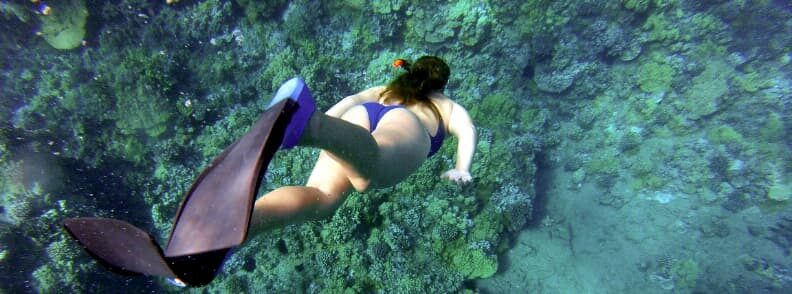
2. Marathon & the Tomb of the Athenians
The site of the famous 490 BCE battle that gave the marathon its name is only about 40 kilometers from Athens. You can visit the Tomb of the Athenians, where fallen soldiers were buried, and the Marathon Archaeological Museum, which contains artifacts from the area’s Neolithic and Classical periods.
While you’re here, you should also head to Lake Marathon to see its pure marble dam. Another option is to head to the bays of Marathon Cape. The latter makes a great destination for those who love to go snorkeling or cliff-diving. By boat, you can also explore the fantastic waters of the isolated island of Dipsa.
A day trip to Marathon is quiet, historically important, and manageable as a short day out.
In case you were wondering, marathons got their name from a legend about a soldier who ran from Marathon to Athens… and died. But that shouldn’t discourage anyone from running a marathon!
3. Skiathos by Air (In Summer)
While most islands require ferry planning, you can fly to Skiathos in under an hour from Athens, making it one of the few Greek islands that work as a day hop, if you start early and return late. It’s best in summer, when daily flights are frequent and the island’s beaches are in top condition. Expect crystal-clear water, pine-fringed shores, and lively beach cafés. You won’t see ruins here, but for a true sea-and-sand escape, it’s hard to beat.

4. Loutraki Thermal Spa
About 85 kilometers away from Athens and near the Corinth Canal, you’ll find the ancient town of Thermae, now known as Loutraki. A classic spa town, Loutraki is known for its thermal springs, seaside promenade, and relaxed atmosphere. It’s close enough for a half-day visit and offers something unique: therapeutic treatments, a small beach, and even a casino if that’s your thing.
Not far, you will find the archaeological site Heraion of Perachora and the Vouliagmeni Lagoon.
You can combine it with a visit to Ancient Corinth or a day trip from Athens to Ancient Olympia. Or go just to soak and slow down. Loutraki is popular with Athenians but still feels very local.

5. Evia Island
Speaking of spa treatments, maybe thermal baths aren’t your thing. Not sure you’ve tried it yet, but maybe a wine spa treatment is for you! It is supposed to help with skin renewal and make you feel more energetic.
You can try this on a visit to Evia, an island bridged to the Greek mainland. The wines in the region have earned medals in both national and international competitions. Try the local wine varieties Malagousia and the rare red Mavrokoundoura of Evia.
6. Kea (Tzia) Island
Kea is one of the Cycladic islands but is rarely visited by tourists, even though it’s only a 60-minute ferry from Lavrio Port. The island has stone paths, hidden beaches, and hilltop villages with sweeping views. Its capital, Ioulida, is car-free and dotted with neoclassical houses and quiet cafés. Kea makes a great day trip if you want a Cycladic feel without the long journey to Mykonos or Paros.

7. Kapsia Cave & Martinia Wine Region
If you’re looking for a unique day trip from Athens, then the Kapsia Cave is definitely worth a visit. Kapsia Cave is one of Greece’s most impressive caves, a true wonder of nature. This underground cave system is full of stunning stalactites and stalagmites, and it’s a fascinating glimpse into the geological history of the area. You can get to Kapsia Cave by car.
Besides visiting Kapsia Cave, this day trip from Athens is a great opportunity to discover Mantinia, one of the famous wine regions in the Peloponnese. Here, you can wander through the vineyards and visit some wineries. If you prefer white wine to red, you should definitely taste the Mantinia wines on one of your day trips from Athens, produced from the aromatic varieties Asproudes and Moschofilero. The latter is a type that is very acidic and can also produce sparkling wines.

8. Vouraikos Canyon & Monastery of Mega Spileon
The day starts in the historic city of Kalavryta, about an hour and a half away from Athens. An interesting visit here is the Museum of the Kalavritan Holocaust.
Like the day trip to Meteora, you’ll find here a route that is really interesting to do by train. Starting in Kalavryta, a small train will take you through the Vouraikos Canyon.
This day trip from Athens is also great for wine lovers. It’s a chance to visit the Monastery of Mega Spileon, a magnificent eight-story complex that is a century-old wine production site. You can walk through the vineyards, admire the canyon, and, of course, taste the wonderful wine!
If you’ve already explored the big-name trips from Athens and want something different, these five ideas will help you uncover lesser-known corners of Attica and beyond.
DIY or Tour from Athens? (And When It Matters)
One of the most important decisions when planning your Athens day trips is whether to go independently or book a tour. There’s no single answer. Some destinations are easy and cheap to reach on your own, while others are time-consuming or logistically complex unless you go with a group. Your choice will depend on your comfort with transport, how much time you have, and how much you value added context from a guide. Below is a breakdown to help you decide when DIY makes sense and when a tour saves time, stress, or both.
Comparison Table: DIY vs Tour for Athens Day Trips
| Destination | Cost (DIY vs Tour) | Time Efficiency | Comfort | Accessibility Without Car |
|---|---|---|---|---|
| Delphi | €30 vs €80-€100 | DIY takes longer | Moderate | Good (KTEL bus) |
| Meteora | €40-€50 vs €100-€120 | Tour is better for one day | High on tour | Limited without train or guide |
| Cape Sounion | €15 vs €50-€70 | DIY is slower | Easy by tour | Good (KTEL bus) |
| Aegina | €20-€25 vs €70-€90 | DIY is best | High | Excellent (ferry) |
| Poros | €25 vs €75-€100 | DIY is best | High | Excellent (ferry) |
| Hydra | €30 vs €90 | Comparable | High | Excellent (ferry) |
| Mycenae + Epidaurus | €40-€50 vs €90-€110 | Tour is easier | Moderate | Poor (requires car or tour) |
| Nafplio | €30 vs €80-€100 | DIY works well | Good | Good (KTEL bus) |
| Ancient Corinth | €15 vs €60 | DIY is fine | Good | Good (train + taxi) |
| Lake Vouliagmeni | €10-€15 vs N/A | DIY is standard | Easy | Very good (taxi or bus) |
Which Trips From Athens Are Best Done by Tour
Meteora is the clearest case where a tour makes more sense. The distance, timing, and monastery closures make DIY tough if you’re trying to visit in a single day. A tour handles transport, entry hours, and gives you access to sites that would otherwise require a car or a long walk. The same goes for Mycenae and Epidaurus, especially if you want to combine both with a stop in Nafplio. Without a rental car, it’s hard to cover this triangle efficiently.
These are also destinations where context matters. A guide can explain the layout of ancient sanctuaries, the importance of local myths, and help bring ruined stone walls to life. If you’re short on time and want to get the most out of your visit, this is where your tour costs pay off.
Which Athens Day Trips Are Easiest by Public Transport
Delphi is manageable on your own thanks to regular KTEL buses from Athens. You won’t have a guide, but the site is well signed and the museum gives plenty of background. Just be sure to confirm bus times in advance and give yourself enough time to see everything without rushing.
Cape Sounion also works as a DIY trip. The coastal KTEL bus route is slow but scenic, and you’ll save money compared to a guided sunset tour. If you want flexibility or are traveling off-season, this is a solid option.
Aegina is one of the best Athens day trips to do independently. Ferries run frequently from Piraeus, and everything on the island is accessible by local bus, taxi, or on foot. There’s no need to pay for an organized group here unless you want commentary or convenience.
The same goes for Poros and Hydra. You can be on and off the boat without much planning, and the islands are walkable and easy to explore at your own pace.
What’s Your Ideal Day Trip From Athens?
Find Your Best Day Trip from Athens
1. How much time do you have?
Choosing the best day trip from Athens depends on matching your energy, time, and access. The rest of this guide breaks down each destination so you can go deeper once you’ve narrowed it down.
Packing & Planning Checklist
Even the best-planned Athens day trips can fall apart if you forget the basics. Whether you’re heading to a mountain monastery, an island port, or a remote archaeological site, what you pack and when you go makes a big difference. To make things easier, I am working on a printable PDF checklist you will be able to download and take with you. It covers everything from footwear and ferry snacks to seasonal tips and ticket quirks. But before you head off, here are the essentials you need to know.
What to Bring for a Smooth Day Trip from Athens
The most important item is sturdy, comfortable footwear. You’ll often be walking on uneven ground, ancient stone steps, or dusty hillsides. Even island strolls involve cobbles and slopes. Sandals are fine for beaches, but not for climbing the Palamidi Fortress or exploring Delphi’s Sacred Way.
Always carry a refillable water bottle, especially in spring through early autumn. Shade is limited at many ruins, and kiosks aren’t always nearby. For sites like Meteora and Mycenae, you’ll also need cash for entry fees. Most ticket booths accept cards, but smaller monasteries or rural cafés may not. A few coins will also help with restrooms or local buses.
If you’re taking the ferry to Aegina, Poros, or Hydra, bring a snack, especially on slower routes. High-speed boats usually have small cafés, but the selection and pricing aren’t great. The same goes for intercity buses to places like Nafplio or Delphi. A few nuts, fruit, or a sandwich can go a long way.
The PDF checklist includes categories for:
- Clothing by season
- Site-specific extras (e.g., monastery dress code, beach towel, sunscreen)
- Transport essentials (ID, ferry e-tickets, printed bus schedules)
Accessibility Tips
Many Athens day trips involve stairs, uneven paths, or steep terrain. If you’re traveling with limited mobility, consider St. Stephen’s Monastery in Meteora, which is accessed by a bridge rather than steps. At Epidaurus, the main theatre is wheelchair-accessible, though the wider sanctuary is not. Cape Sounion has a clear path to the temple area but involves light inclines.
For island visits, stick to Aegina or Hydra, where the main port towns are walkable and relatively flat. Be cautious on Poros if mobility is limited because the clocktower climb and much of the town sit on a hill.
Public transport infrastructure is improving, but not all rural buses or trains are easily accessible. If in doubt, book a small-group tour with confirmed accessibility support.
Best Time of Year for Each Trip
Spring (April-early June) and autumn (late September-October) are the best seasons for almost all Athens day tours. Temperatures are manageable, crowds are lighter, and the light is better for photos. This is especially true for open-air sites like Mycenae, Delphi, and Meteora.
Summer can be intense, with midday heat and heavy traffic on island ferries. If you’re traveling in July or August, leave early and plan for breaks in shaded cafés. That said, summer is perfect for Aegina, Poros, and Lake Vouliagmeni, where swimming is part of the plan.
Winter (November-March) has benefits: free entry days, cooler weather, and near-empty ruins. But opening hours are shorter, ferry routes may be reduced, and trains can run on limited schedules. Still, for places like Ancient Corinth or Nafplio, this can be the ideal time to explore without the rush.
Your Athens Day Trips FAQs, Answered
When planning day trips from Athens, a few questions come up again and again, especially for first-time visitors. Here’s what you really need to know, based on experience, not guesswork. These answers are practical, honest, and shaped by how travel around Athens actually works, whether you’re on a tight schedule or just trying to avoid tourist traps.
Can I do a day trip from Athens without a car?
Yes, and in many cases, it’s the better option. Destinations like Aegina, Poros, Hydra, Delphi, Cape Sounion, and Ancient Corinth are all reachable by public transport or ferry. Buses (KTEL), trains (Proastiakos), and high-speed boats run regularly and are generally on time.
For places like Meteora or the Mycenae-Epidaurus-Nafplio triangle, you’ll get the most out of the day with a guided tour or a car. But if you plan carefully, even those can be done without one. For simplicity and budget, car-free is absolutely doable, and often more relaxing.
Is Meteora worth it for a day?
Yes, if you take the train or a tour. The drive is long and tiring, and parking can be tricky. But the scenery, the monasteries, and the overall atmosphere make it one of the most memorable day trips you can do from Athens.
If you go by train, take the earliest Intercity departure and plan to stay until the last return. Even with only a few hours on site, visiting two or three monasteries will leave a big impression. If you have the flexibility, stay overnight in Kalambaka, but don’t skip it just because you only have one day.
What’s the best island near Athens?
That depends on what you’re after. For ease and variety, Aegina wins: temple, beaches, great food, and a short ferry ride. For quiet beauty, Poros is ideal, especially off-season. For elegance and no cars, Hydra offers something special with great walking spots and art shops.
If you want a full day without stress, Aegina is your safest bet. If you want atmosphere and don’t mind walking, Hydra or Poros are more rewarding.
Where to go from Athens with kids?
Choose trips with minimal travel time and lots of outdoor space. Lake Vouliagmeni is great for swimming and relaxing. Aegina works well for pistachio treats, short ferry rides, and small beaches. Ancient Corinth offers manageable ruins and wide-open paths. Cape Sounion is exciting for mythology-loving kids and ends with a sunset.
Avoid long road trips unless your kids nap in transit. Meteora and Delphi are incredible, but better for teens than toddlers.
How far in advance should I book a tour?
For popular day tours like Meteora, Delphi, or the Saronic Islands Cruise, book at least 3 to 5 days in advance, especially in spring and summer. For July and August, a week ahead is safer.
Off-season or weekday tours often have more availability, but last-minute bookings risk disappointment, especially for small-group experiences or anything involving train tickets.
If you’re traveling during a Greek holiday or cruise-heavy weekend, book as early as possible.
Make the Most of Your Athens Base
Staying in Athens isn’t just about the Acropolis and the Plaka. It’s your gateway to a huge range of landscapes, ruins, and local experiences, all reachable in a matter of hours. From ancient mountaintop sanctuaries to island harbors, thermal lakes, and dramatic monasteries, these Athens day trips make it easy to mix big sights with smaller surprises, without changing hotels or packing your suitcase twice.
Using Athens as your base means you can move at your own pace. You can squeeze in a sunset at Cape Sounion, hop to Aegina for pistachios and a temple, or lose yourself in Meteora’s cliffs, and still be back in time for dinner in the city.
If you’re ready to plan smarter, don’t miss the free tools I’ve included to make things easier:
👉 Download the printable Packing & Planning Checklist
👉 Use the interactive map (coming soon!) to see which day trips fit your schedule
👉 Sign up for my Athens Travel Guide on Rexby for route ideas, ferry hacks, snack stops, and planning tips I learned the hard way.
Athens is a fantastic destination, but don’t limit your vacation to just the city. Take advantage of the amazing day trip options available and explore the best of what Greece has to offer. From history and culture to stunning natural landscapes and beaches, these day trips from Athens are not to be missed. So pack your bags, plan ahead, and get ready to make unforgettable memories!
About the Author

Hi, I’m Mirela Letailleur, your go-to guide for the best day trips from Athens Greece. I’m originally from Romania but now live in the sunny South of France, where I blend my love for local culture, smart planning, and strong coffee into everything I share on The Travel Bunny, my travel blog for budget-conscious explorers.
Over the years, I’ve planned dozens of Athens day trips for myself, my family, and thousands of readers who want to see more of Greece without overspending or overthinking. From ancient sites to island escapes like Aegina and Poros, I’ve done it all, often the hard way, so you don’t have to.
I specialise in affordable travel in Europe, with a sharp focus on Greece travel planning, practical problem-solving, and real, first-hand advice. My mission is to help you spend less, see more, and travel better without sacrificing depth or experience. If you’re planning to explore Athens and its best day trips, I’m here to help you do it smarter, cheaper, and with more confidence. You’ll find guides, itineraries, and local tips throughout my blog, all built around real travel.
After planning the best day trips from Athens, here are some travel articles you’ll enjoy on The Travel Bunny blog
Travel to Athens – what to look out for
Private transportation in Athens, including renting a car or scooter
Where to stay in Santorini on a budget

